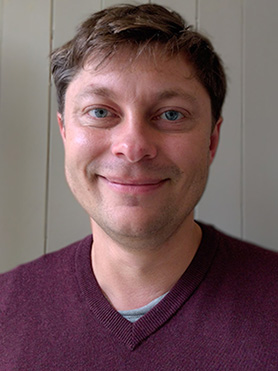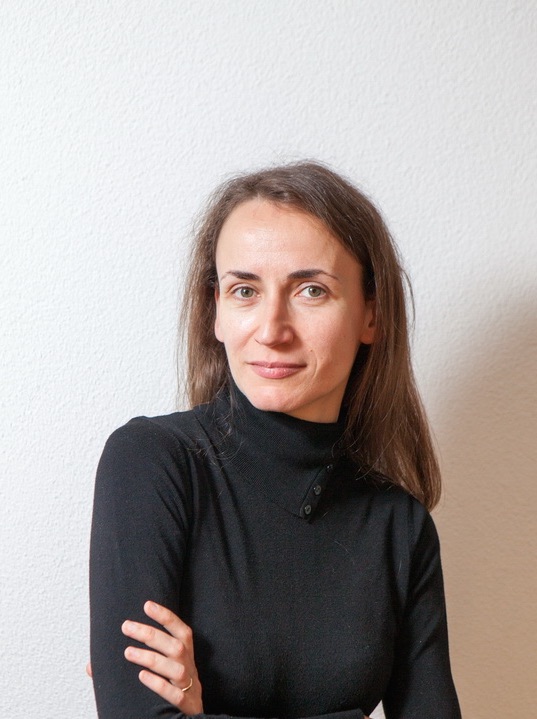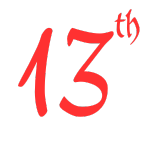Dr Mark Faulkner
Trinity College Dublin
The Twain Shall Meet: Rethinking the Relationship between ‘Old’ and ‘Middle’ English

Mark Faulkner is Ussher Assistant Professor in Medieval Literature in the School of English at Trinity College Dublin. He has published widely on twelfth-century English and is the author of A New Literary History of the Long Twelfth Century: Language and Literature between Old and Middle English (Cambridge University Press, 2022) and editor of the forthcoming Critical Anthology of Twelfth-Century English: Writing the Vernacular in the Transitional Period (Arc Humanities Press). He is especially interested in the material realisation of written texts, and is co-editing the three-volume History of Punctuation in English Literature (Cambridge University Press).
Another strand of his work, evident in articles like ‘Habemus Corpora: Reapproaching Philological Problems in the Age of Big Data’ centres on bringing new quantitative precision to our understanding of the medieval textual record. He collaborates frequently with computer scientists, including linked data specialists, NLP experts, machine learning experts and computational statisticians. Current major projects include Ansund, a new open access corpus of Old English based on Handwritten Text Recognition, and the development of techniques for semi-automated linguistic profiling and cluster analysis of medieval texts.
Mark has also worked closely with Trinity’s Library to increase public access to manuscripts through lecture series like Beyond the Book of Kells and the Carnegie-funded Manuscripts for Medieval Studies project, and founded and directs the Trinity Centre for the Book, having also developed Trinity’s manuscript-focused M. Phil in Medieval Studies.
We have grammars of Old English, we have grammars of Middle English; we have dictionaries of Old English, we have dictionaries of Middle English; we teach courses on Old English, we teach courses on Middle English; and, dare one say it, we have conferences on Old English, conferences on Middle English.
This partitioning is the first thousand years of English’s history is of long standing, but predicated on a number of self-enforcing myths. For instance, when the disciplines of literary and linguistic history were crystalising in the ninteteenth century, nationalist ideas that inextricably linked language with nation coalesced with the myth of the Norman Yoke to encourage a belief that the Norman Conquest must also have been a linguistic conquest, with English necessarily displaced. In this view, nothing could have been written in English in the twelfth century, a prejudice that discouraged scholars from seeking out texts that might have been and forced them to assign those that could be to an earlier or later date and dismiss those that couldn’t be thus brushed aside as sui generis. Looking for nothing meant nothing was found, providing evidence that nothing had been written in the twelfth century. The vacant twelfth century also justified delineating Old and Middle English as separate varieties, by sidelining the texts that might have problematised such a clearcut distinction.
This paper revisits the twelfth century from the perspective of both literary history and historical linguistics, to explore the extent to which a periodisation into ‘Old’ and ‘Middle’ English is sustainable today. It investigates this question from several angles: (1) quantitatively, using metadata about the sites and personnel for the production and dissemination of English-language texts assembled as part of the Searobend project (Faulkner, O’Sullivan, Curran, McKenna) and through the examination of large datasets for the major linguistic changes held to demark ‘Old’ and ‘Middle’ English (e. g. Faulkner 2020); (2) qualitatively, through tracing the history of particular kinds of writing at particular centres in the long twelfth century (Faulkner 2022, forthcoming) and through the examination of particular features of those texts’ language.
References
Faulkner, Mark. 2020. Quantifying the Consistency of “Standard” Old English Spelling. Transactions of the Philological Society 118: 192-205.
Faulkner, Mark. 2022. A New Literary History of the Long Twelfth Century: Language and Literature between Old and Middle English. Cambridge: Cambridge UP.
Faulkner, Mark. Forthcoming. A Critical Anthology of Twelfth-Century English: Writing the Vernacular in the Transitional Period. York: Arc Humanities Press
Faulkner, Mark, Declan O’Sullivan, Colleen Curran and Lucy McKenna, Searobend: Linked Metadata for English Language Texts, 1000-1300
Laing, Margaret. 2000. “Never the twain shall meet» early Middle English — the east west divide. In I. Taavitsainen, et al (eds.), Placing Middle English in Context. Berlin: Mouton. 97-124.
Dr David Moreno-Olalla
Universidad de Málaga
The study of scribal formulas in Middle English manuscripts: or, Linguistics vindicated and Literature abashed

David Moreno Olalla is Senior Lecturer at the University of Málaga, where he teaches Old and Middle English. His main field of expertise is Historical Linguistics, with particular reference to Middle English Dialectology, but he is also interested in Textual Criticism and dabbles in Manuscript Studies. His research is focused on the transmission of English technical Fachliteratur, herbals in particular, composed during the Middle Ages and the early Tudor period. He is currently working on a critical edition of a hitherto unknown translation, made during the late 1300s somewhere in the Scottish Marches, of the famous Latin medical poem De Viribus Herbarum.
Composed in either doggerel Latin or (rarely) some European vernacular, the formulaic inscriptions that (post-)medieval scribes penned by the thousand in the colophons of chronicles, glossaries, cookery books, medical tracts, legal digests or mystic poems has been the province of literary scholars at least since the times of Thomas Warton and Paulin Paris. A trove of witty sentences, ranging from the philosophical to the bawdy and from the elegiac to the festive, it is hardly surprising that these ditties have caught the imagination of many academics working with manuscripts. A number of inferences were soon made as to the actual physical and mental state of the copyist while (s)he selected a formula and, whenever the inscription granted it, an interest sprang on the life particulars of the person who decided to jot down the jingle on a book page. But are those rhyming inscriptions really trustworthy?
In the first part of this talk I will demonstrate some of the problems caused by such an impressionistic approach. I will use for the purpose a jingle that scholars have long assumed to have medieval English origins because it is very frequently encountered in manuscripts from that country. In the second part of the talk a new approach will be presented that applies a time-honoured and reliable linguistic tool to the same medieval inscription, so as to prove ultimately that most, if not all, scholarly preconceptions about these sentences should better be discarded. Through this new methodology, moreover, the history of any popular scribal ditty can be described with a degree of precision that was surely impossible heretofore, allowing to build data-driven hypotheses that can help pinpoint the birth of any given formula in time and space and clarify the way it spread through Europe.
References
Bénédictins du Bouveret. (1965–1982). Colophons des manuscrits occidentaux des origines au XVIe siècle. Fribourg: Editions universitaires.
Friedman, J. B. (1995). Northern English books, owners, and makers in the late Middle Ages. Syracuse (N.Y.): Syracuse University Press.
Paris, A. P. (1836–1848). Les manuscrits françois de la Bibliothèque du roi: leur histoire et celle des textes allemands, anglois, hollandois, italiens, espagnols de la même collection. Paris: Techener.
Reynhout, L. (2006). Formules latines de colophons. Turnhout: Brepols.
Thorndike, L. (1937). Copyists’ final jingles in mediaeval manuscripts. Speculum, 12(2), 268.
Thorndike, L. (1956). More copyists’ final jingles. Speculum, 31(2), 321–328.
Warton, T. (1774–1781). The history of English poetry from the close of the eleventh to the commencement of the eighteenth century. London-Oxford: J. Dodsley et al.
Professor Olga Timofeeva
University of Zurich
T/V variation in Middle English versions of “The Knight and the Loathly Lady”

Olga Timofeeva is professor of English historical linguistics at the University of Zurich. Her early specialisation was in Old English syntax, and she has since published on a broad range of subjects, including Old and Middle English lexis, language contact and second language acquisition in the Middle Ages, historical sociopragmatics, and the evolution of legal register in early English. She is the author of Non-finite Constructions in Old English (Société Néophilologique de Helsinki, 2010) and Sociolinguistic Variation in Old English: Records of Communities and People (Benjamins, 2022).
The long history of English pronominal terms of address is that from the universal use of the singular form thou in the Old English and Early Middle English period, irrespective of social standing, age, gender, level of formality or intimacy, to the equally universal use of the plural (and historically oblique) form you in Modern English (Finkenstaedt 1963; Blake 1992; Burnley 2003; Bergs 2004; Jucker 2020). The emergence of the plural pronoun in singular contexts in the second half of the thirteenth century is considered by many to have been triggered by contact with French (Mustanoja 1960; Finkenstaedt 1963; Heine & Kuteva 2009). Unlike English, French has retained the distinction between polite vous and familiar tu, but in the Middle Ages the distribution of the two pronominal options in both languages was far from stable (Blake 1992). Furthermore, it has been argued that in Middle English the system of pronouns of address was characterized by retractable choices, i.e. the appropriate pronoun was negotiated and even renegotiated by interlocutors in the course of a single conversation (Mazzon 2000, 2009, 2010), and their interactional status was decisive for the choice of that pronoun (Jucker 2006, 2014, 2020).
This pronominal system has been extensively documented in studies based primarily on Chaucer’s poetry, which has naturally raised the question of its validity in prose, as well as in other Middle English authors. The imbalance has partly been addressed in Bergs (2004), which uses a database of Middle English correspondence, and in Timofeeva & Kahlas-Tarkka (fc 2025), based on The Book of Margery Kempe. With verse, Mazzon (2009) has extended the scope of address terms enquiries to mystery plays and Jucker (2014) to Sir Gawain and the Green Knight. These studies document a predictable expansion of ye across time and region and a gradual restriction of thou to pragmatically marked contexts. At the same time, into Late Middle English, pronominal switches from ye to thou as well as from thou to ye remain a feature of individual writers, individual texts and individual interactions within texts, to the extent that they have been suggested to “serve dramatic purposes” and to “coincide with turning-points in the narrative” (Jucker 2006: 63).
This plenary talk will explore whether a historical pragmatic approach can indeed illuminate stylistic and narratological analysis, by comparing three versions of “The Knight and the Loathly Lady” story: Chaucer’s The Wife of Bath’s Tale, Gower’s The Tale of Florent, and the anonymous The Wedding of Sir Gawain and Dame Ragnelle. It is going to demonstrate what dramatic effects can be achieved by pronominal switches and how the protagonists of the three romances can be constructed linguistically through second-person pronouns.
References
Bergs, Alexander T. 2004. “Address pronouns in Late Middle English.” In Voices on the Past. Studies in Old and Middle English Language and Literature, ed. by Francisco Alonso Almeida, and Alicia Rodrigues Alvarez, 127-138. A Coruña: Netbiblo.
Blake, Norman. 1992. “The literary language.” In The Cambridge History of the English Language, Vol. 2, 1066-1476, ed. by Norman Blake. Cambridge, 500-541. Cambridge: University Press.
Burnley, David. 2003. “The T/V pronouns in later Middle English literature.” In Diachronic Perspectives on Address Term Systems, [Pragmatics & Beyond New Series 107], ed. by Irma Taavitsainen, and Andreas Jucker, 27-45. Amsterdam: John Benjamins.
Finkenstaedt, Thomas. 1963. “You und Thou: Studien zur Anrede im Englischen, mit einem Exkurs über die Anrede im Deutschen.” Berlin: Walter de Gruyter.
Heine, Bernd, and Tania Kuteva. 2009. “Towards linguistic unity in Europe.” In Eurolinguistik: Entwicklungen und Perspektiven: Akten der internationalen Tagung vom 30.9.-2.10.2007 in Leipzig, ed. by Uwe Hinrichs, Norbert Reiter, and Siegfried Tornow, 141-164. Wiesbaden: Harrassowitz Verlag.
Jucker, Andreas H. 2006. “‘Thou art so loothly and so oold also’: the use of ye and thou in Chaucer’s Canterbury Tales.” Anglistik 17 (2): 57-72.
Jucker, Andreas H. 2014. “Courtesy and politeness in Sir Gawain and the Green Knight.” Studia Anglica Posnaniensia 49 (3): 5-28.
Jucker, Andreas H. 2020. Politeness in the History of English: From the Middle Ages to the Present Day. Cambridge: Cambridge University Press.
Mazzon, Gabriella. 2000. “Social relations and forms of address in the Canterbury Tales.” In The History of English in a Social Context: A Contribution to Historical Sociolinguistics, ed. by Dieter Kastovsky, and Arthur Mettinger, 135-168. Berlin: Mouton de Gruyter.
Mazzon, Gabriella. 2009. Interactive Dialogue Sequences in Middle English Drama. Amsterdam/Philadelphia: John Benjamins.
Mazzon, Gabriella. 2010. “Terms of address.” In Jucker, Andreas H., and Irma Taavitsainen (eds.), 351-376.
Mustanoja, Tauno F. 1960. A Middle English Syntax, Part 1: Parts of Speech [Mémoires de la Société Néophilologique de Helsinki 23]. Helsinki: Société Néophilologique.
Timofeeva, Olga & Leena Kahlas-Tarkka. Fc 2025. “yet ar ye not lyche, for thu art a fals strumpet: Pronominal terms of address in The Book of Margery Kempe.” Journal of Historical Pragmatics.

